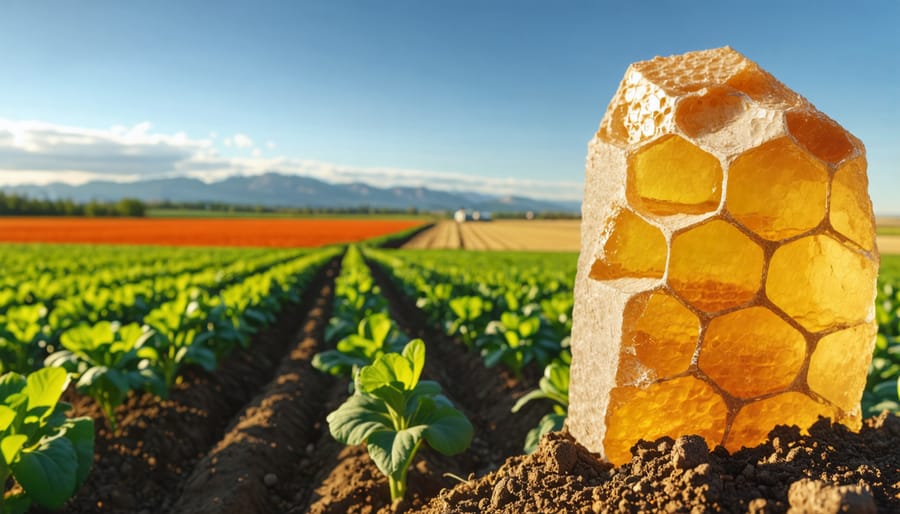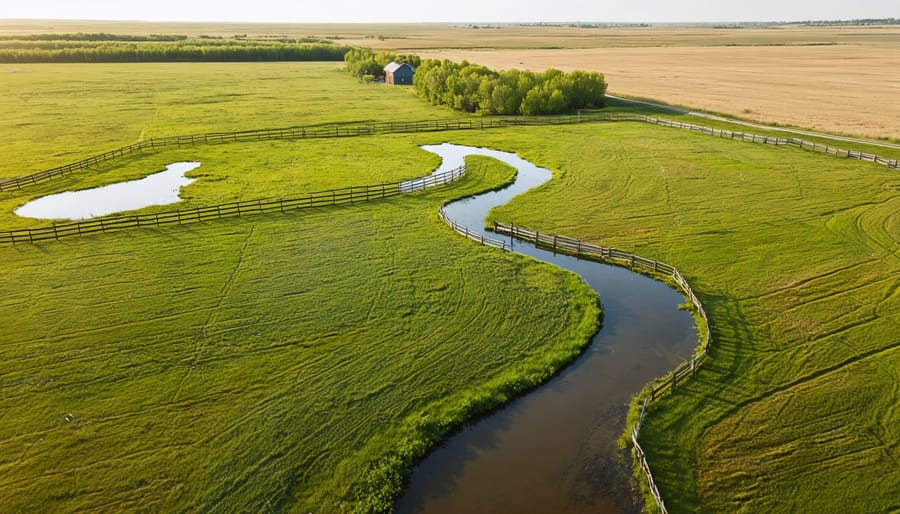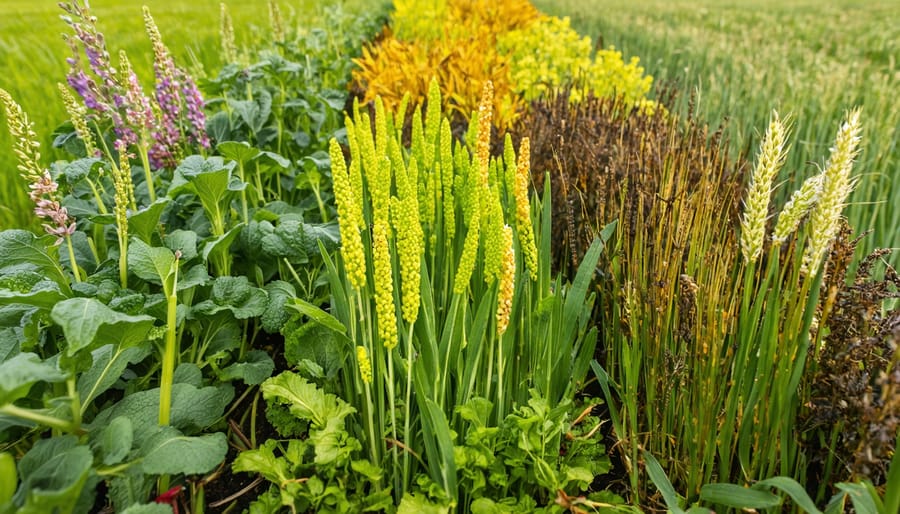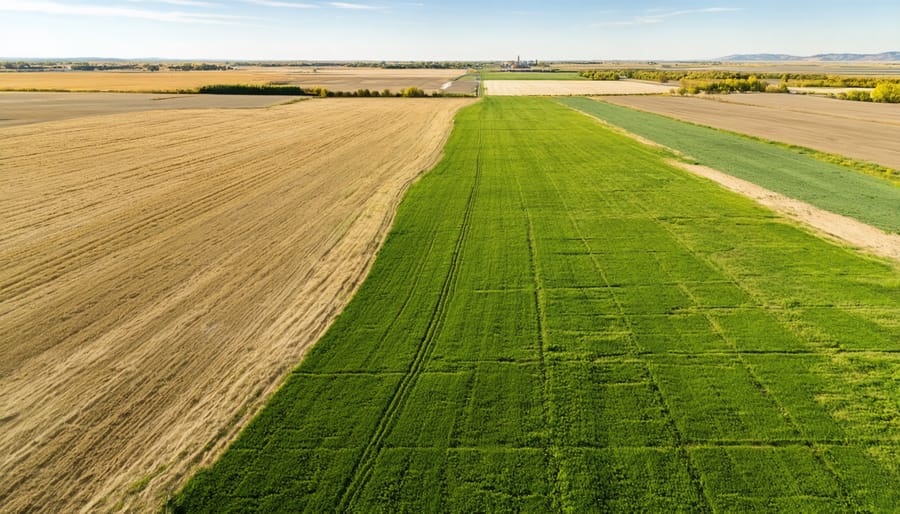Transform depleted farmland into high-yield growing zones with zeolite, a crystalline mineral amendment that’s revolutionizing soil management across Alberta’s agricultural landscape. This naturally occurring aluminosilicate doesn’t just improve soil structure—it creates a powerful, long-lasting foundation for sustainable crop production by trapping essential nutrients and maintaining optimal moisture levels. For farmers facing challenging soil conditions, from sandy loams to heavy clay, zeolite’s unique molecular structure acts as a microscopic reservoir system, holding onto valuable nutrients and water that would otherwise wash away with rainfall or irrigation. Canadian producers have reported up to 20% yield increases in the first season after application, while simultaneously reducing fertilizer requirements by 15-25%. As global fertilizer costs continue to rise and weather patterns become increasingly unpredictable, zeolite soil amendment offers a practical, cost-effective solution for building resilient agricultural systems that maintain productivity through challenging growing seasons.
How Zeolite Works in Your Soil
The Science Behind Zeolite’s Benefits
At its core, zeolite is a naturally occurring mineral with a unique honeycomb-like crystalline structure. This microscopic framework consists of interconnected channels and pores that give zeolite its remarkable properties. The mineral’s structure contains negatively charged aluminum and silicon atoms, balanced by positively charged ions like calcium, potassium, and sodium.
When added to soil, zeolite’s molecular architecture acts like a natural sieve, trapping and releasing nutrients as needed. The porous structure can hold up to 55% of its weight in water, creating a balanced moisture environment for plant roots. This same structure also provides an ideal habitat for beneficial soil microorganisms.
What makes zeolite particularly effective is its high cation exchange capacity (CEC). Think of it as a nutrient bank where essential elements are stored and released gradually. When fertilizers are applied, zeolite captures excess nutrients, preventing them from leaching away. This stored goodness is then slowly released to plants when they need it most, improving nutrient efficiency and reducing fertilizer waste.
In Alberta’s varied soil conditions, this molecular structure helps maintain consistent soil chemistry, supporting healthy crop development throughout the growing season.
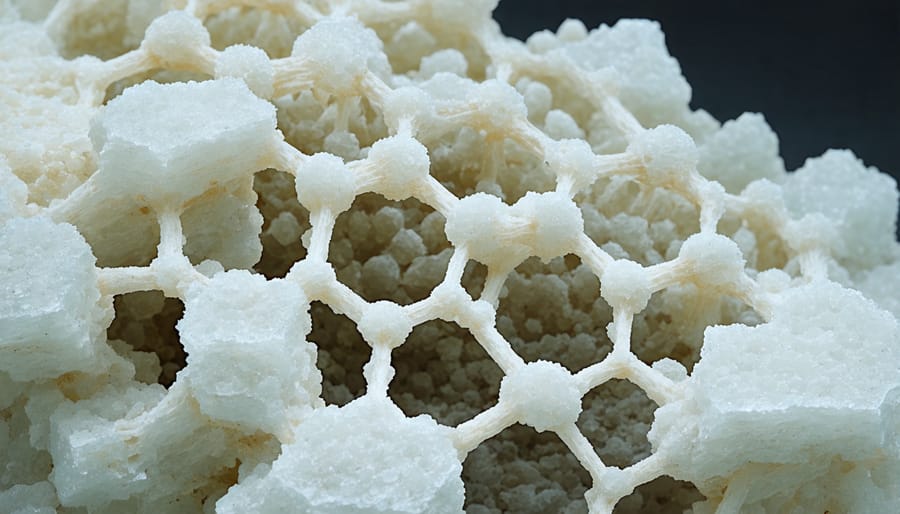
Key Properties for Alberta Soils
Alberta’s unique soil conditions, ranging from brown chernozemic soils in the south to gray luvisols in the north, make zeolite particularly valuable for local agriculture. The mineral’s exceptional ability to improve soil health addresses several key challenges faced by Alberta farmers.
The province’s soil typically has low cation exchange capacity (CEC), which limits nutrient retention. Zeolite’s high CEC helps hold essential nutrients in the root zone, reducing fertilizer leaching – a common issue in sandy Alberta soils. During our dry periods, zeolite’s water-holding capacity helps maintain consistent soil moisture, particularly beneficial for irrigation management in southern Alberta.
Our cold climate and short growing season mean efficient nutrient uptake is crucial. Zeolite’s ability to slowly release nutrients aligns perfectly with crop growth cycles in our region. For areas dealing with high pH soils, common in central Alberta, zeolite helps buffer soil pH and improves nutrient availability to plants. The amendment also proves valuable in reducing soil compaction, a growing concern in areas with heavy equipment traffic during wet spring conditions.
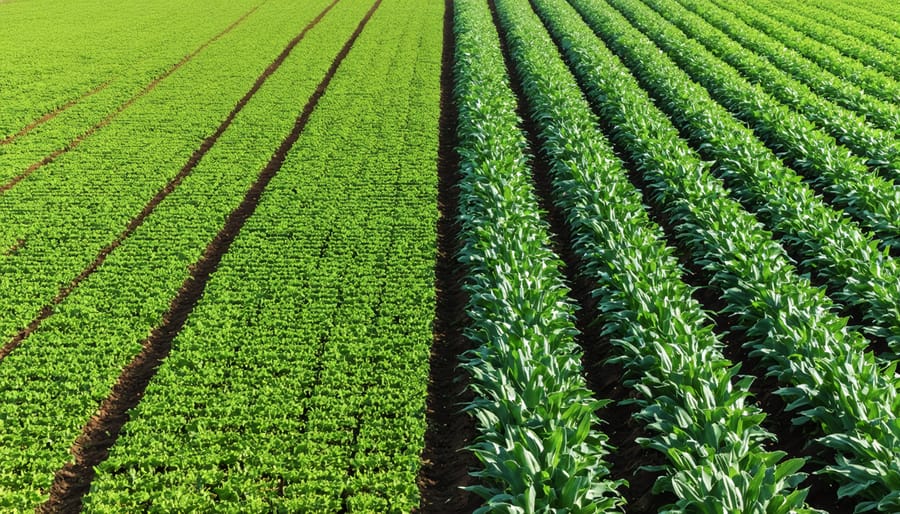
Practical Benefits for Your Farm
Water Retention and Management
One of zeolite’s most valuable properties is its remarkable ability to retain and manage water efficiently in soil systems. The mineral’s honeycomb-like structure creates countless microscopic pores that can hold up to 55% of their weight in water, acting like tiny reservoirs throughout your soil profile. This improved water infiltration and retention means less frequent irrigation and reduced water waste.
For Alberta farmers dealing with variable precipitation patterns, zeolite helps maintain consistent soil moisture levels during dry spells while preventing waterlogging during heavy rains. The mineral releases stored water gradually as plants need it, creating an ideal growing environment that can reduce irrigation requirements by up to 30%.
When incorporated into sandy soils, zeolite significantly improves water-holding capacity, while in clay soils, it enhances drainage and prevents compaction. This dual benefit makes it particularly valuable for farms with mixed soil types. Many producers in southern Alberta have reported substantial water savings after adding zeolite to their irrigation systems, especially during critical growing periods.
Nutrient Management
Zeolite’s unique molecular structure makes it a powerful tool for nutrient management in Alberta’s diverse soil conditions. The mineral’s honeycomb-like framework acts as a natural reservoir for essential nutrients, significantly reducing fertilizer leaching and improving overall nutrient efficiency.
When applied to soil, zeolite captures and holds ammonium, potassium, and other positively charged nutrients that would otherwise wash away during irrigation or heavy rainfall. This retention capability means farmers can typically reduce their fertilizer application by 20-30% while maintaining or even improving crop yields.
What makes zeolite particularly valuable for Alberta farmers is its ability to release nutrients gradually as plants need them. This slow-release mechanism creates a more stable growing environment and helps prevent nutrient burning, a common concern in intensive farming operations.
Local success stories demonstrate zeolite’s effectiveness in nutrient management. For instance, a grain farmer near Red Deer reported a 25% reduction in nitrogen fertilizer use after incorporating zeolite into their soil amendment program, while maintaining consistent yield levels. The mineral’s high cation exchange capacity (CEC) also helps balance soil pH, creating optimal conditions for nutrient uptake.
For best results, incorporate zeolite at a rate of 2-5 tonnes per hectare, depending on your soil type and specific crop requirements.
Environmental Benefits
Zeolite’s unique properties make it an environmentally responsible choice for soil amendment, aligning with many of the environmental benefits of organic farming. Its most significant environmental advantage is the reduction of nutrient leaching into groundwater and nearby water systems. The mineral’s crystalline structure acts as a natural filter, holding onto excess nutrients that would otherwise wash away during rainfall or irrigation.
For Alberta farmers dealing with sandy soils, zeolite helps reduce the need for frequent fertilizer applications by improving nutrient retention. This not only cuts down on input costs but also minimizes the environmental impact of excess fertilizers entering our waterways. Studies conducted at several Canadian research stations have shown up to 40% reduction in nitrogen leaching when zeolite is properly incorporated into the soil.
The long-lasting nature of zeolite means fewer applications are needed over time, reducing the carbon footprint associated with transportation and application of soil amendments. Its ability to help balance soil pH also decreases the need for lime applications in acidic soils, further contributing to sustainable farming practices. By supporting healthy soil biology and reducing chemical inputs, zeolite helps create more resilient and environmentally sustainable farming systems.
Application Methods and Best Practices
Application Rates and Timing
For most Alberta soils, the recommended application rate of zeolite ranges from 5 to 10 tonnes per hectare, depending on your specific soil conditions and crop requirements. Sandy soils typically benefit from higher application rates (8-10 tonnes/ha) due to their lower natural ability to retain nutrients, while clay-rich soils may need less (5-7 tonnes/ha).
For row crops like canola and wheat, incorporate zeolite into the soil during spring preparation, ideally 2-3 weeks before seeding. When using zeolite in vegetable gardens or specialty crops, mix 2-3 kg per square metre into the top 15-20 cm of soil.
A single application can remain effective for 5-10 years, though some farmers report best results with smaller annual applications of 2-3 tonnes per hectare. For new agricultural land or severely degraded soils, consider an initial application of 10-12 tonnes per hectare, followed by maintenance applications every 3-5 years.
When applying zeolite as a soil amendment, timing is crucial. Fall application allows winter precipitation to help incorporate the material into the soil profile. However, spring application just before tillage is equally effective, particularly in areas with limited fall working windows.
Remember to adjust these rates based on soil test results and specific crop needs. Many Alberta farmers find success by starting with a moderate application rate and monitoring soil improvement over time.

Integration with Existing Farm Practices
Integrating zeolite into your existing farm practices doesn’t require a complete overhaul of your current operations. When it comes to revitalizing agricultural soil, zeolite can be easily incorporated during regular field preparation or fertilizer application.
For crop farming, apply zeolite during spring tillage or fall field preparation at rates between 2-5 tonnes per hectare, depending on your soil conditions. Mix it into the top 15-20 cm of soil using standard equipment like cultivators or disc harrows. If you’re already using a fertilizer spreader, you can blend zeolite with your regular fertilizer application, reducing the number of passes needed across your field.
For greenhouse operations, incorporate zeolite into your growing medium at 5-10% by volume before planting. When amending established gardens or smaller plots, work it into the soil at a rate of 2-3 kg per square metre.
Many Alberta farmers have found success by starting with a test plot to observe results before expanding application. This approach allows you to adjust rates based on your specific soil needs and crop response. Remember to maintain your regular soil testing schedule to monitor improvements and adjust application rates accordingly.
For best results, apply zeolite when soil moisture levels are adequate, typically in early spring or after harvest. This timing allows the amendment to integrate well with the soil before the growing season begins.
Cost Considerations and ROI
When evaluating zeolite as a soil amendment, farmers across Alberta report a positive return on investment, typically within 2-3 growing seasons. Initial costs range from $200 to $400 per tonne, with application rates varying from 5 to 10 tonnes per hectare, depending on soil conditions and crop requirements.
While the upfront investment might seem substantial, zeolite’s long-lasting effects can span 5-10 years, significantly reducing the per-season cost. Local farmers have reported 15-30% increases in crop yields, particularly in water-stressed conditions, which can translate to an additional $150-$300 per hectare in annual revenue for common Prairie crops like canola and wheat.
The economic benefits extend beyond yield improvements. Farmers typically see a 20-25% reduction in fertilizer costs due to zeolite’s ability to retain nutrients. Water consumption often decreases by 15-20%, leading to lower irrigation costs and improved drought resilience. These savings can amount to $75-$100 per hectare annually.
For organic producers, zeolite’s natural composition makes it an especially valuable investment, as it helps maximize the efficiency of organic fertilizers and can command premium prices for produce. Several Alberta agricultural grants and sustainability programs may also offset initial costs, making the investment more accessible for farmers looking to improve their soil quality long-term.
Alberta Success Stories
Local farmers across Alberta have experienced remarkable results with zeolite soil amendments, demonstrating the mineral’s effectiveness in our unique climate and soil conditions. Near Lethbridge, third-generation farmer Mike Anderson reported a 23% increase in canola yields after incorporating zeolite into his sandy loam soil three years ago. “The difference was noticeable within the first growing season,” Anderson shares. “Not only did our yields improve, but we reduced our fertilizer use by about 15%.”
In the Peace River region, Sarah Thompson’s family farm struggled with nutrient retention in their heavy clay soil. After adding zeolite at a rate of 4 tonnes per hectare, they observed improved soil structure and better water management. “Our fields used to get waterlogged in spring, but now the drainage is much better,” Thompson explains. “We’ve seen more consistent crop emergence and stronger root development.”
The Rodriguez family farm near Red Deer provides another compelling example. Their vegetable operation faced challenges with nitrogen leaching in their irrigated fields. By incorporating zeolite into their soil amendment program, they reduced irrigation frequency by 30% while maintaining optimal soil moisture levels. Their tomato and pepper crops showed increased resistance to common stress factors during Alberta’s unpredictable summer weather.
Perhaps most notably, the Cooper Valley Cooperative, involving fifteen farms in central Alberta, conducted a three-year trial comparing zeolite-amended fields with traditional practices. The study revealed average yield increases of 18% across various crops, including wheat, barley, and pulses. Additionally, soil tests showed improved cation exchange capacity and more stable pH levels throughout the growing season.
These success stories highlight zeolite’s adaptability to various Alberta growing conditions and its potential to address common agricultural challenges in our region. The documented improvements in water retention, nutrient efficiency, and crop yields demonstrate why more local farmers are incorporating this amendment into their soil management strategies.
As we’ve explored, zeolite soil amendment offers significant benefits for Alberta farmers, from improved water retention to enhanced nutrient efficiency. By starting with small test plots of 2-3 hectares, you can evaluate zeolite’s effectiveness for your specific soil conditions. Remember to conduct regular soil tests and maintain detailed records of your results. Consider connecting with local agricultural extension offices or joining farmer networks to share experiences and learn from others who have implemented zeolite amendments. With proper application rates of 5-10 tonnes per hectare and consistent monitoring, zeolite can be a valuable tool in building healthier, more productive soils for sustainable farming in our region. Take the first step by consulting with local suppliers and developing an implementation plan that works for your operation.

